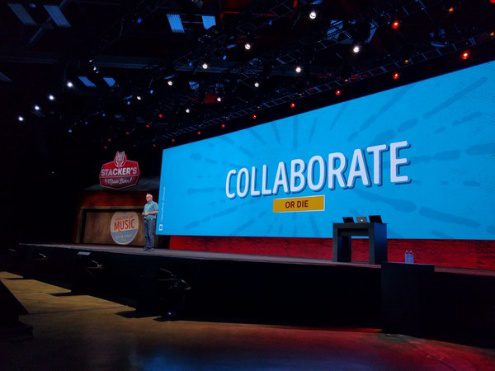AUSTIN – In the early days of the Internet, it was the LAMP (Linux, Apache, MySQL, PHP) stack that enabled the rapid growth of the Web. For the new era of the cloud, what will be the LAMP stack of the cloud? That’s a question asked by Mark Collier, Chief Operating Officer of the OpenStack Foundation at the OpenStack Summit here.
Collier noted that growing demand for infrastructure is driving a need for a new stack. While OpenStack is part of the solution, it’s not necessarily the entire solution. Collier added that there are other tools and communities that OpenStack needs to embrace.
“The same way that users drove the LAMP stack to be more valuable than the sum of its parts, we have to listen to our users,” Collier said. “So if they can combine OpenStack with other things that’s a good thing.”
The biggest companies in the world world, including Walmart, AT&T and China Mobile, are now using OpenStack. Collier said that what those companies have realized is that they have to embrace open technologies to thrive. He added that all those large organizations are changing their culture and they are doing it because they have to in order to succeed and thrive. Collier said that companies today must collaborate or they will die.
Collier emphasized that if the largest companies in the world can collaborate, then OpenStack can collaborate too with other open-source efforts.
“The emerging stack will be OpenStack and a number other technologies ,” Collier said.
Collier brought executives from Time Warner Cable and LivePerson on stage to discuss how they are using OpenStack together with other technologies. Time Warner Cable is using Apache Mesos to help manage its OpenStack cloud efforts, while LivePerson is moving to a containerized architecture.

At the OpenStack Summit
Among the tools used by many organizations as part of a complete cloud deployment are Kubernetes and containers. Alex Polvi, the CEO of CoreOS, demonstrated how his firm is building a Kubernetes based tool that enables the containerized deployment of OpenStack. The CoreOS tool is a a fully containerized OpenStack running on top of Kubernetes. In a live demonstration, Polvi deployed an OpenStack service and also destroyed a service, in order to demonstrate self-healing capabilities.
“OpenStack is just an application, made up of some python code, and it’s subject to installation and lifecycle management like any other application,” Polvi said.
Sean Michael Kerner is a senior editor at Datamation and InternetNews.com. Follow him on Twitter @TechJournalist
Huawei’s AI Update: Things Are Moving Faster Than We Think
FEATURE | By Rob Enderle,
December 04, 2020
Keeping Machine Learning Algorithms Honest in the ‘Ethics-First’ Era
ARTIFICIAL INTELLIGENCE | By Guest Author,
November 18, 2020
Key Trends in Chatbots and RPA
FEATURE | By Guest Author,
November 10, 2020
FEATURE | By Samuel Greengard,
November 05, 2020
ARTIFICIAL INTELLIGENCE | By Guest Author,
November 02, 2020
How Intel’s Work With Autonomous Cars Could Redefine General Purpose AI
ARTIFICIAL INTELLIGENCE | By Rob Enderle,
October 29, 2020
Dell Technologies World: Weaving Together Human And Machine Interaction For AI And Robotics
ARTIFICIAL INTELLIGENCE | By Rob Enderle,
October 23, 2020
The Super Moderator, or How IBM Project Debater Could Save Social Media
FEATURE | By Rob Enderle,
October 16, 2020
FEATURE | By Cynthia Harvey,
October 07, 2020
ARTIFICIAL INTELLIGENCE | By Guest Author,
October 05, 2020
CIOs Discuss the Promise of AI and Data Science
FEATURE | By Guest Author,
September 25, 2020
Microsoft Is Building An AI Product That Could Predict The Future
FEATURE | By Rob Enderle,
September 25, 2020
Top 10 Machine Learning Companies 2020
FEATURE | By Cynthia Harvey,
September 22, 2020
NVIDIA and ARM: Massively Changing The AI Landscape
ARTIFICIAL INTELLIGENCE | By Rob Enderle,
September 18, 2020
Continuous Intelligence: Expert Discussion [Video and Podcast]
ARTIFICIAL INTELLIGENCE | By James Maguire,
September 14, 2020
Artificial Intelligence: Governance and Ethics [Video]
ARTIFICIAL INTELLIGENCE | By James Maguire,
September 13, 2020
IBM Watson At The US Open: Showcasing The Power Of A Mature Enterprise-Class AI
FEATURE | By Rob Enderle,
September 11, 2020
Artificial Intelligence: Perception vs. Reality
FEATURE | By James Maguire,
September 09, 2020
Anticipating The Coming Wave Of AI Enhanced PCs
FEATURE | By Rob Enderle,
September 05, 2020
The Critical Nature Of IBM’s NLP (Natural Language Processing) Effort
ARTIFICIAL INTELLIGENCE | By Rob Enderle,
August 14, 2020

Datamation is the leading industry resource for B2B data professionals and technology buyers. Datamation's focus is on providing insight into the latest trends and innovation in AI, data security, big data, and more, along with in-depth product recommendations and comparisons. More than 1.7M users gain insight and guidance from Datamation every year.
Advertise with TechnologyAdvice on Datamation and our other data and technology-focused platforms.
Advertise with Us
Property of TechnologyAdvice.
© 2025 TechnologyAdvice. All Rights Reserved
Advertiser Disclosure: Some of the products that appear on this
site are from companies from which TechnologyAdvice receives
compensation. This compensation may impact how and where products
appear on this site including, for example, the order in which
they appear. TechnologyAdvice does not include all companies
or all types of products available in the marketplace.